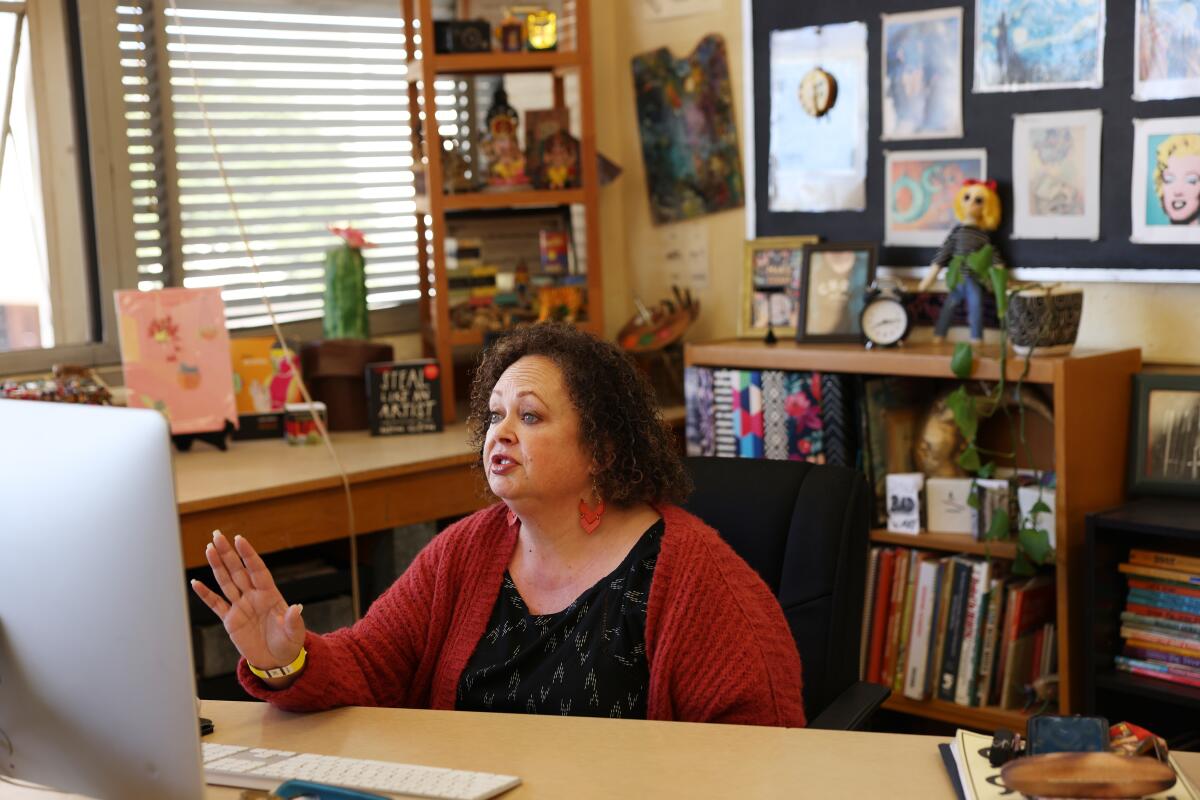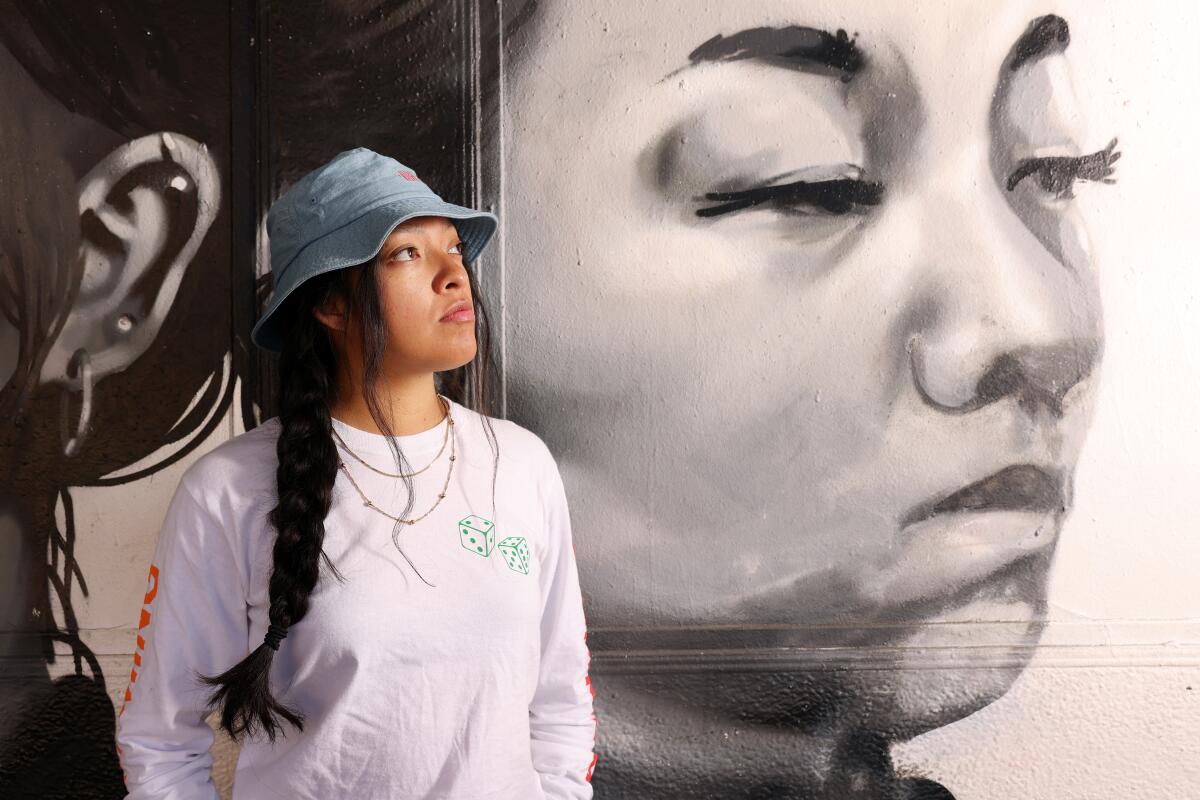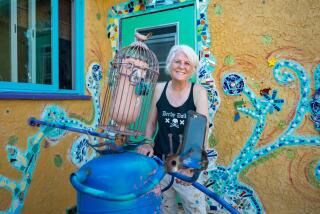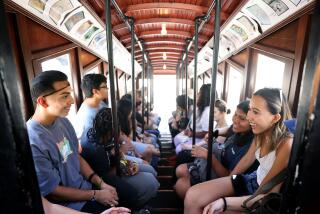How Long Beach students are turning mail into the most personal art
Artist Diana L. Sánchez earned her bachelor’s in fine arts at Cal State Long Beach as a recipient of the Deferred Action for Childhood Arrivals program, the 2012 Obama policy that allows immigrants without legal status to live and work in the United States. But the bulk of her family remains in the Mexican state of Querétaro.
“To this day,” she said, “there’s something special about seeing my parents receive letters from my grandparents after being separated for decades.”
Fittingly, Sánchez used a postal envelope as her canvas for an illustration of a monarch butterfly perched on a woman sporting “Abolish ICE” hoop earrings. Before the rise of social media and affordable international phone calls, she said, letters were how her family kept in touch with loved ones across the border. Monarch butterflies, which journey from the north to Mexico every year, represent “migration and resilience.” She hopes her work will encourage others to re-imagine the U.S. immigration system and craft policy in which migrants cease to be “this imaginary threat that justifies injustices and cruelty.”
Sánchez’s artwork is part of an initiative called Couriers of Hope, which will give 400 Long Beach Unified School District students the opportunity to exchange their artwork with more than 80 professional artists — some of whom can command tens of thousands of dollars for their work.
The students and artists all were tasked with exploring the concept of hope using an envelope as a canvas.
Ten local museums and galleries helped to identify the pro artists and bring them into the program. Work by these professional artists is on window display at the Psychic Temple of the Holy Kiss in downtown Long Beach through Feb. 28, enabling the public to see the exhibition from the sidewalk during the pandemic. The 160 pieces of original work also can be viewed online. The student artists will use the digital gallery to select three artists with whom they will propose to trade.
Once the students complete their work, they will request to trade their envelope for a work by one of the professional artists. The artists are not obligated to make a trade. They will do so if they value and feel a connection to the work.
The exchange is organized by the nonprofit arm of Intertrend, a marketing and advertising agency with ties to the city’s art scene. With the support of the JAG Molina Family Foundation Fund and other donors, it provided students with supplies like markers, colored pencils and paint pods, along with an envelope with thread ties. Providing the supplies, Intertrend Chief Executive Julia Huang said, was an essential part of the trading program, which aims to reduce barriers to access in the art world. When communicating with students, organizers stressed that “we can all be artists, art collectors and art appreciators.”

Art made on new or found envelopes, Huang said, channels the mail art movement of the 1960s, which valued egalitarian ways of making and distributing art.
The decision to use envelopes as the official canvases, added Intertrend project manager Cassandra Leeman, speaks to the importance of connecting with one another at a time when so many of our relationships have been relegated to screens.
After a year full of reasons to despair, the initiative’s organizers sought to compel young people to consider what keeps them going. And so amateur and professional participants alike were asked to respond to the questions: What brings you hope? What are you hoping for? How do you picture it?
Piggybacking off his previous work, artist Yoskay Yamamoto contributed two original pieces to the art exchange. One features a placid moon, the other portrays a girl submerged in water. Both, he said, are meant to exude a sense of calm and peace.
“I felt that’s something we all needed, and that’s something I wanted for myself too,” Yamamoto said. “Even though I’m accustomed to spending time by myself, hearing about tragic news every day isn’t something I’m used to.”
Yamamoto, who has showed in galleries and museums around the world and whose works include a site-specific installation at Facebook’s headquarters in the Bay Area, hopes the trading program will help students see that it’s possible to make a living as an artist.
“Luckily, even in college I was very interested in art, so I surrounded myself with people who were doing artsy kinds of things. I was always inspired and encouraged,” he said. “But some people might not be in those fortunate situations. For students who don’t have a family member or friends who are involved in the art world, this can be almost like a bridge that they can walk across to see what is possible.”
Christine Whipp, who oversees the school district’s arts curriculum, echoed this sentiment. “It’s important for students to be able to imagine themselves in that world,” she said.
Jessica Vallejo, a soccer-loving junior at Millikan High School who is devoting her envelope to the plight of endangered sea turtles, noted that “no one has ever seen my art outside of the classroom.” She’s equally nervous and excited about the chance to trade her work.
Elisa Hodgson, a freshman at the same school, has been drawing since she was little, but before this school year she’d had no formal training. Her art teacher, Antoinette Bailey, has helped her to improve her ability to depict spatial depth. For Couriers of Hope, she’s hard at work on an envelope featuring images of spring.
Artist Karina Vázquez, a graduate of Jordan High School, said including students in the arts community is pivotal.
After a peaceful protest against racism and police brutality last spring was later marred by a separate group of people who broke windows and stole from stores in and around downtown, Long Beach residents returned to the streets to clean up. Students and local artists were part of those cleanup crews, and some brought art supplies. After sweeping up the broken glass, they transformed dozens of boarded-up windows and doors into murals, reclaiming their hometown.
“It was amazing to see the Long Beach community out there cleaning and painting, just showing up for our city and for our people,” said Vázquez, who lives and works in the area and was among the volunteers.
When asked to partake in the trading program, she readily agreed. She contributed three pieces.
Guided by photographs provided by Border Kindness, a nonprofit that provides migrants with support that ranges from food to legal services, she used graphite, watercolor and acrylic to create portraits of children awaiting asylum at the U.S.-Mexico border.
In that vein, Alepsis Hernández, whose murals can be found throughout L.A. County, used an envelope from the Department of Homeland Security for her piece, “Answers From Above.”
Hernández’s mother was 12 when she came to this country. Now 44, she recently became a legal resident of the United States — and received the news in that very envelope.
Hernández’s contribution to Couriers of Hope also speaks to a recent experience in Phoenix. Her father and an uncle passed away when she was 12, she said. Since then, she’d lost contact with that side of the family. The pandemic gave her the opportunity to reconnect. She drove to Arizona to meet a second cousin, who gave her a photograph of her paternal great-grandmother.
“I had a lot on my mind when I was driving out there,” Hernández said. “I had, like, this missing piece, and I was questioning my life as an artist, my purpose. Without even telling her what was going on inside of me, she answered all the questions.”

When Hernández got back to California, she used acrylic to paint her maternal grandmother holding the photograph. It was a way to stitch her families — and herself — back together.
“When I started thinking about ‘hope,’ I asked myself, ‘What has this time, this pandemic really brought to me?’” she said. “For me, it’s been about slowing down and reconnecting. And that’s new, because I’m always, like, work, work, work.”
More to Read
The biggest entertainment stories
Get our big stories about Hollywood, film, television, music, arts, culture and more right in your inbox as soon as they publish.
You may occasionally receive promotional content from the Los Angeles Times.











